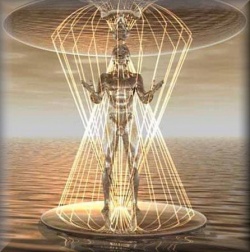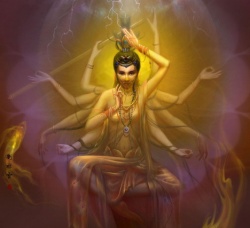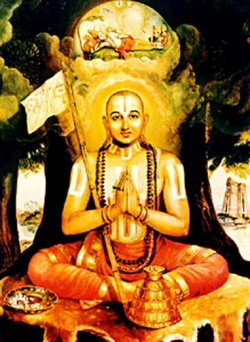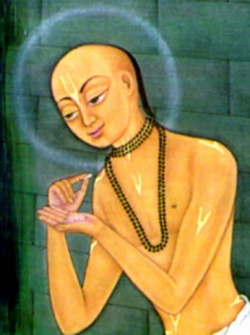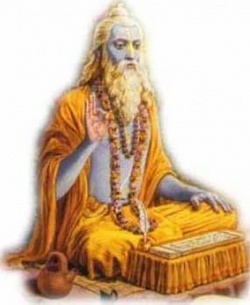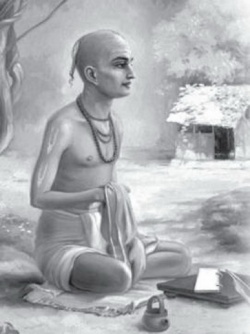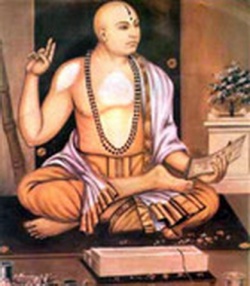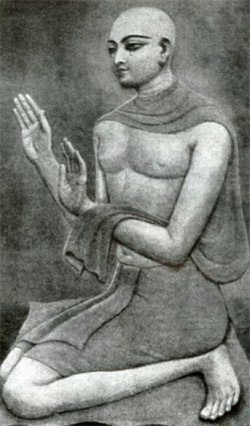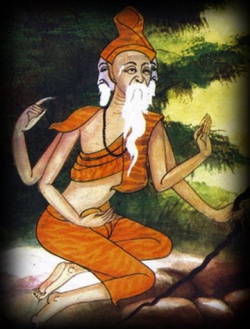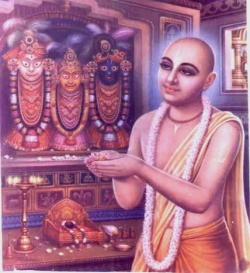Mindstream
Mindstream in Buddhist philosophy is the moment-to-moment "continuum" (Sanskrit : saṃtāna) of awareness . There are a number of terms in the Buddhist literature that may well be rendered "mindstream ". For these, see below.
[[File:Tapihritsa01.jpg|thumb|250px|An example of an iconographic representation of the mindstream ,(Tibetan thangka ) of Tapihritsa)]
The mindstream doctrine , like most Buddhist doctrines , is not homogeneous and shows historical development, different applications according to context and varied definitions employed by different Buddhist traditions .
Summary
Most Buddhist schools are committed doctrinally to anātman (Pali : anattā), "non-self ," the teaching that none of the things perceived by the senses constitute a "self ." As Thanissaro Bhikkhu explains, "...the Buddha was asked point-blank whether or not there was a self , he refused to answer. When later asked why, he said that to hold either that there is a self or that there is no self is to fall into extreme forms of wrong view that make the path of Buddhist practice impossible." Scholar Herbert V. Gunther further explains, "an individual, which in other systems is imagined as a combination of matter and a permanent mental principle (ātman), is in reality a continuously changing stream of that which from one viewpoint is believed to be matter and from another a mind . However, what we call the mental and the material occurs in a unity of organization. Organization is something dynamic."
In discussing the continuity of mind or awareness in the absence of a self , various words and concepts have been employed. "Mindstream " is often used both colloquially and in more scholarly discourse, as when Dzogchen Rinpoche writes "[t]he Buddhadharma is a process, one through which we train and tame our own mindstreams . One approach is to go to the root of what we mean by 'I,' our sense of self or individual self -identity." According to scholar Wiliam Waldron, "Indian Buddhists see the 'evolution' of mind i[n] terms of the continuity of individual mind -streams from one lifetime to the next, with karma as the basic causal mechanism whereby transformations are transmitted from one life to the next."
Scholar Caroline Augusta Foley Rhys Davids (1903: pp. 587–588) assesses Louis de La Vallée-Poussin's work on "mindstream " in Buddhism :
- Professor de la Vallee Poussin finds a very positive evolution of vijnana -theory in certain Sanskrit -Buddhist texts . The term samtana is joined to or substituted for it — a term which seems to approximate to our own neopsychological concept of mind as a 'continuum' or flux. And he infers from certain contexts that this vijnana-samtana was regarded, not as one permanent, unchanging, transmigrating entity, as the soul was in the atman -theory, but as an "essential series of individual and momentary consciousnesses ," forming a "procession vivace et autonome." By autonomous he means independent of physical processes. According to this view the upspringing of a new vijnana at conception, as the effect of the preceding last vijnana of some expiring person, represents no change in kind, but only, to put it so, of degree. The vijnana is but a recurring series, not a transferred entity or principle. Hence it is more correct, if less convenient, to speak, not of vijnana , but of the samtana of pravrtti-vijnanani.
In Vajrayāna (tantric Buddhism ) "mindstream " may be understood as an upāya metaphor for the nonlocal, atemporal stream of moments (Tibetan : bkod-pa thig-le) or "quanta of consciousness " (Tibetan : thig-le; Sanskrit : bindu ). It proceeds endlessly in a lifetime, in between lifetimes (Tibetan : bardo ), from lifetime to lifetime, prior to engagement in the wheel of life , through samsara and beyond. It does so as an inclusive "continuum" (Tibetan : rgyud) rather than an individuated, separate, or discrete perceptual, cognitive, or experiential entity, as in the Buddhadharma conception of the ātman which is diametrically opposed to the Atman of the Upanishads.
A yogin who has recognized the inseparability of samsara and nirvana is said to dwell in (Wylie: zung-'jug; Sanskrit : yuganaddha ) In the entwined Dzogchen traditions of Bönpo and Nyingmapa , the mindstream constitutes a continuum of gankyil composed of the five pure lights of the five wisdoms which unite the trikāya. These tantric correlations (or "twilight language ") are evident in the iconographic representation of the five Jīnas and the saṃpanna-krama of the gankyil and mandala in Dzogchen practice. The "supreme siddhi " or "absolute bodhicitta" of the Dzogchenpa is when the stream of their bodymind (namarupa) is "released" (in nirvana ) as the rainbow body .
Terms
Buddhist scholar Alexander Berzin uses the term "mental continuum" in translation of the Tibetan sems-rgyud and Sanskrit santāna, which he defines as "the stream of continuity of mental activity (mind , awareness ) of an individual being, which has no beginning, which continues even into Buddhahood , and, according to Mahayana , has no end. According to the Hinayana tenets, it comes to an end when an arhat or Buddha dies at the end of the lifetime in which the person attains liberation or enlightenment . Also called a 'mind-stream .'" The doctrinal understanding of the mindstream concept in Buddhist traditions evolved over centuries and varies to some extent by tradition .
Sanskrit
Citta -saṃtāna (Sanskrit ) has been defined as "literally, 'the stream of mind ,' a general term used to indicate the continuity of the personality of an individual in the absence of the permanently abiding "self " (ātman) that Buddhism denies." Citta holds the semantic field of "that which is conscious ", "the act of mental apprehension known as ordinary consciousness ", "the conventional and relative mind /heart ". Citta has two aspects: "...Its two aspects are attending to and collecting of impressions or traces (Sanskrit : vāsanā) cf. vijñāna." Saṃtāna or santāna (Sanskrit ) holds the semantic field of "eternal", "continuum", "a series of momentary events" or "life -stream".
Tibetan
Citta is often rendered as sems in Tibetan and saṃtāna corresponds to rgyud, which holds the semantic field of "continuum", "stream", and "thread"--Citta-saṃtāna is therefore rendered sems rgyud. Interestingly, rgyud is the term that Tibetan translators (Tibetan : lotsawa ) employed to render the Sanskrit term "tantra ".
Thugs-rgyud is a synonym for sems rgyud--Thugs holds the semantic field: "Buddha -mind ", "(enlightened ) mind ", "mind ", "soul ", "spirit ", "purpose", "intention", "unbiased perspective", "spirituality ", "responsiveness", "spiritual significance", "awareness ", "primordial (state, experience)", "enlightened mind ", "heart ", "breast", "feelings " and is sometimes a homonym of "citta " (Sanskrit ). Thugs-rgyud holds the semantic field "wisdom ", "transmission ", "heart -mind continuum", "mind ", "[[[Wikipedia:continuum|continuum]]/ stream of mind ]" and "nature of mind ."
Chinese , Korean and Japanese
The Chinese equivalent of Sanskrit citta-saṃtāna and Tibetan sems-kyi rgyud ("mindstream ") is xin xiangxu (simplified Chinese : 心相续; traditional Chinese : 心相續; pinyin: xīn xiāngxù; Wade–Giles: hsin hsiang-hsü). According to the Digital Dictionary of Buddhism , xīn xiāngxù means "continuance of the mental stream" (from Sanskrit citta-saṃtāna or citta -saṃtati), contrasted with wú xiàngxù 無相續 "no continuity of the mental stream" (from asaṃtāna or asaṃdhi) and shì xiāngxù 識相續 "stream of consciousness " (from vijñāna-saṃtāna).
This compound combines xin 心 "heart ; mind ; thought ; conscience; core" and xiangxu "succeed each other", with xiang 相 ”each other; one another; mutual; reciprocal" and xu 續 or 续 "continue; carry on; succeed". Thus it means "thoughts succeeding each other".
Xin xiangxu is pronounced sim sangsok in Korean and shin sōzoku in Japanese .
Mental "stream" metaphors
The metaphorical use of "stream" to describe mentality is characteristic of but not unique to the Buddhist literature and worldview. In English for example, "stream of consciousness " is more familiar than "mindstream ".
William James promoted the "stream of consciousness " with its particular nomenclature, some state drawn from Bain (refer following), whilst immersed in Buddhist studies and the accompanying protracted spiritual discipline of vipaśyanā, as related by Wallace (2003):
- Buddhologist Roger R. Jackson similarly portrays Buddhist meditation as a type of ritual act (Jackson 1999:231). While such characterizations are certainly valid for some types of Buddhist meditation , they are profoundly misleading for the practices of meditative quiescence (samatha ) and contemplative insight (vipasyana ), which are the two core modes of Buddhist meditative training. Techniques of meditative quiescence entail the rigorous cultivation of attentional stability and vividness, methods having a strong bearing on William James’s psychological theories of attention (Wallace 1998, 1999a).
Buddhism
There are two entwined mindstreams according to the two truths, the absolute and relative, that are ultimately non-dual according to Atiyoga . One is the divine mindstream of "consciousness " which is engaged in the phowa practice, for example; the other the mindstream of thought and ideation (Tibetan : sem; Sanskrit : manas ) (vṛtti-citta ).
Gyatso, Jinpa and Wallace (2003: p. 97) identify two kinds of consciousness continua and associate the most subtle state of consciousness continuum, elsewhere identified in this article as the "mindstream substrate", with what is known in Tibetan Buddhist , Dzogchen and Bonpo discourse as "clear light " (Tib: 'od-gsal):
- In Vajrayāna Buddhism the subtlest state of consciousness is known as clear light . In terms of categories of consciousness , there is one type of consciousness that consists of a permanent stream or an unending continuity and there are other forms of consciousness whose continuum comes to an end. Both these levels of consciousness - one consisting of an endless continuum and the other of a finite continuum - have a momentary nature. That is to say, they arise from moment to moment, and they are constantly in a state of flux. So the permanence of the first kind is only in terms of its continuum. The subtlest consciousness consists of such an eternal continuum, while the streams of the grosser states of consciousness do end.
Sogyal Rinpoche (1994: p. 73) frames the importance of the stream metaphor in relation to meditation and the nature of mind , the objective of a meditative sādhana :
- In the ancient meditation instructions, it is said that at the beginning thoughts will arrive one on top of another, uninterrupted, like a steep mountain waterfall. Gradually, as you perfect meditation , thoughts become like the water in a deep, narrow gorge, then a great river slowly winding its way down to the sea, and finally the mind becomes like a still and placid ocean, ruffled by only the occasional ripple or wave.
Bucknell et al. (1986: pp. 112–113) find numerous references to a stream of thought and imagery :
- In Buddhist literature the mental condition in which sequences of imagery and verbalizing run on endlessly is often compared to a flowing stream. We find in the oldest section of the Tipiṭaka the term "stream of consciousness " (viññāṇa-sotaṃ). The same metaphor is often found in the Tibetan literature. The guru Padma Karpo spoke of "thoughts ...following one after the other as if in a continuous stream"; Mipham Nampar Gyalba observed, the "stream of images flows unbroken"; and in the Vow of Mahāmudrā, there is reference to 'the mind river '. This manner of speaking is also common at the present day. Tarthang Tulku refers to "the stream of mental images" and 'the flow of thoughts and images'; and David-Neel, in a discussion of the meditation practices she observed in Tibet , speaks of "the continual, swift, flowing stream of thoughts and mental images..."
Psychology
The term, "stream of consciousness " was coined by the philosopher Alexander Bain in 1855 and later popularized by the psychologist, William James. Bain (1855: p. 380) wrote, "The concurrence of Sensations in one common stream of consciousness , — on the same cerebral highway, — enables those of different senses to be associated as readily as the sensations of the same sense." After originating in psychological theory, the "stream of consciousness " metaphor became more common in English usage, and was adapted into different contexts, for instance, the stream of consciousness (narrative mode) in literary criticism.
James' classic 1890 Principles of Psychology used several "stream" metaphors . Chapter 9, "The Stream of Thought " describes "the stream of consciousness " as constantly changing and "sensibly continuous":
- Consciousness , then, does not appear to itself chopped up in bits. Such words as "chain" or "train" do not describe it fitly as it presents itself in the first instance. It is nothing jointed; it flows. A "river " or a "stream" are the metaphors by which it is most naturally described. In talking of it hereafter, let us call it the stream of thought , of consciousness , or of subjective life .
"Mental stream" occurs in another context:
- The continuous flow of the mental stream is sacrificed, and in its place an atomism, a brickbat plan of construction, is preached, for the existence of which no good introspective grounds can be brought forward, and out of which presently grow all sorts of paradoxes and contradictions, the heritage of woe of students of the mind .
The psychologist Edward B. Titchener (1909: p. 19) used "mind-stream " to differentiate "mind " from "consciousness ":
- We shall therefore take mind and consciousness to mean the same thing. But as we have the two different words, and it is convenient to make some distinction between them, we shall speak of mind when we mean the sum-total of mental processes occurring in the life -time of an individual, and we shall speak of consciousness when we mean the sum-total of mental processes occurring now, at any given "present" time. Consciousness will thus be a section, a division, of the mind-stream .
Historical development of the Mindstream doctrine
Formative context
Koslowski (2003: p. 67, note 1) states that a suite of worldviews of Indic origin, including Hinduism , Buddhism , Jainism and Sikhism, are known collectively as 'Sanatāna traditions '. In the listing of seven notions that are common to the "Sanatāna traditions " Koslowski (2003: p. 74) identifies one of the seven principles as "Santati or Pravāha-ekatva" where 'santati' (Sanskrit ) denotes "continuum" and 'pravāha' (Sanskrit ) denotes "stream, river " and 'ekatva' (Sanskrit ) denotes "one truth ":
- Santati or Pravāha-ekatva (Continuity of life from the beginning-less situation to the end): Process from the beginning-less state to the liberation of life -forms has a causal continuity. This continuity of life -form is terminated only on the attainment of its nature. Each life -form is an instance of continuum and embodies a unity of process it undergoes. Life -forms are condemned to be possessed with such a continuum except perhaps in the state of liberation (if your theory demands that). On the details of the nature of causal processes underlying continuity, different sub-traditions differ significantly, but reality of continuity of life -form is acceptable to all the sub-traditions . Formal continuity between one state of life to the other state of life is accepted irrespective of this or that state. All life -forms embody this continuity, but characterization of the continuum and its embodiment differs in the different sub-traditions .
For an understanding of the Buddhist traditions emergent in India and the development of their various views, it is important to affirm the dialogic forum of the Abhidharma as does King:
- Buddhist philosophical debate in India took place within an Abhidharmic context.
As Chatterji (1931: pp. 206–207) states:
- Now all the schools of Brahmanic philosophy have posited some permanent entity, i.e. soul as the cognizer to which cognition is variously related. The Buddhists have, however, denied the existence of any such permanent entity. The aggregates of rupa , samjna , samskara, vedana and vijnana ,- the first corresponding to what we call material elements and all the rest to mental elements - are the stuff of which an individual is made. Cognition which is not subservient to any intelligent being, is referred as the samjna skandha or the vijnana skandha according as it is determinate (savikalpa) or indeterminate (nirvikalpa). The place of the transcendental atman is taken by vijnana . It is the continuity of cognition (santana) which holds together, unifies and synthesizes the fleeting moments of cognition and seems to give us the notion, though erroneous, of a subject or a knower acquiring knowledge both presentative (nirvikalpa or svalaksana) and representative (savikalpa or samanyalaksana). This is in general the Buddhist view on the nature of the pramatr or the subject. But there are some notable points of difference among the various schools.
Early Buddhist context
Y Karunadasa (1999, 2000) holds that early Buddhism and early Buddhist discourse "often refer to the mutual opposition between two views":
- "permanence" or "eternalism" (Pali : sassatavada ) also sometimes referred to as "the belief in being" (Pāli: bhava -ditti); and
- "annihilation" or "nihilism " (Pāli: ucchadevada) also sometimes referred to as "the belief in non-being" (Pāli: vibhava-ditti).
As Buddha relates to Kaccānagotta in the Kaccānagotta Sutta as rendered in English by the Myanmar Piṭaka Association Editorial Committee (1993: p. 35):
- For the most part, Kaccāna, sentient beings depend on two kinds of belief - belief that "there is" (things exist) and belief that "there is not" (things do not exist).
Y Karunadasa (1999) states:
- ...it is within the framework of the Buddhist critique of sassatavada and ucchadavada that the Buddhist doctrines seem to assume their significance. For it is through the demolition of these two world -views that Buddhism seeks to construct its own world -view. The conclusion is that it was as a critical response to the mutual opposition between these two views that Buddhism emerged as a new faith amidst many other faiths .
In Yogācāra
Mañjuśrīmitra states in the Bodhicittabhavana, a seminal early text of Ati Yoga :
- The mental-continuum (citta-santana) is without boundaries or extension; it is not one thing, nor supported by anything.
Mindstream is a conflation subsuming "heartmind" (Sanskrit : bodhicitta ) and "wisdom-mind " (Sanskrit :jñāna-dharmakāya; Tibetan : ye-shes chos-sku).
Lusthaus (n.d.) in mapping the development and doctrinal relationships of the store consciousness (ālaya-vijñāna), Buddha nature (tathāgatagarbha), Yogācāra, the self (ātman), Abhidharma , primordial substrative nature (prakṛti) and the mindstream states:
- Several Yogācāra notions basic to the Abhidharma wing [of Yogācāra) came under severe attack by other Buddhists , especially the notion of ālaya-vijñāna, which was denounced as something akin to the Hindu notions of ātman (permanent, invariant self ) and prakṛti (primordial substrative nature from which all mental , emotional and physical things evolve). Eventually the critiques became so entrenched that the Abhidharma wing atrophied. By the end of the eighth century it was ecliped by the logico-epistemic tradition [of Yogācāra) and by a hybrid school that combined basic Yogācāra doctrines with Tathāgatagarbha thought . The logico-epistemological wing in part sidestepped the critique by using the term citta-santāna, "mind-stream ", instead of ālaya-vijñāna, for what amounted to roughly the same idea. It was easier to deny that a "stream" represented a reified self . On the other hand, the Tathāgatagarbha hybrid school was no stranger to the charge of smuggling notions of selfhood into its doctrines , since, for example, it explicitly defined the tathāgatagarbha as "permanent, pleasurable, self , and pure (nitya, sukha , ātman, śuddha). Many Tathāgatagarbha texts, in fact, argue for the acceptance of selfhood (ātman) as a sign of higher accomplishment . The hybrid school attempted to conflate tathāgatagarbha with the ālaya-vijñāna.
Capriles (2004: p. 35) defines the consciousness of the base-of-all (Skt.: ālayavijñāna; Tib.: kun-bzhi rnam-shes ) as congruent with the mindstream and mentions vāsanā, bījas, and tathatā:
- The consciousness of the base-of-all was not conceived as an immutable absolute , which is how the Atman of Hinduism is described; in agreement with the Hinayana idea of a succession of instants of knowledge , it was explained as a continually changing stream of consciousness (Skt., santana; Tib., gyü), and was said to be the vehicle that carries the karmic imprints (vasanas or bijas) that go from one life to the next. In turn, from the standpoint of experience, the consciousness of the base-of-all is an ample condition that yogis may find by absorption. Though the consciousness of the base-of-all is of the nature of thatness (Skt., tathata ; Tib., dezhinnyi) — the absolute nature that is the single constituent of all entities — this consciousness is also the root of samsara .
The word "atman " is used in tathagatagarbha literature after being defined or re-qualified in a new, idiosyncratic way. The Buddha-Nature Treatise for example defines "self " as the perfection of the anātman-pāramitā. Thus one realizes his or her "true self " by perfecting his or her understanding of the truth of anātman. (See Atman .)
Dzogchen (2007: p. 84) asserts an unsourced paraphrase or pastiche of a view attributed to Nagarjuna :
- Nagarjuna says that the mindstream of every unenlightened being is permeated by the heart essence of buddhahood . The fundamental nature of our mindstreams is tathagatagarbha , or buddha nature , the seed and heart essence of an enlightened being. It is this quality that gives us the capacity to become buddhas .
The view in the direct quotation above is generally attributed to the Yogācāra. It is clear that the first sentence in the above quotation holds the position attributed to Nāgārjuna. It is unclear whether the latter two sentences in the quotation are also that of Nāgārjuna, or alternatively the position of Dzogchen Rinpoche .
Waldron (2003: p. 178) renders Vasubandhu 's Yogacara account from the Abhidharmakośabhāṣya of cyclic causality (bhavacakra ), kleśa and karma in relation to the mindstream :
- ...the mind stream (santāna) increases gradually by the mental afflictions (kleśa) and by actions (karma ), and goes again to the next world . In this way the circle of existence is without beginning."
King (1998), referring to Lambert Schmithausen's book Alayavijnana , holds:
[[<File:Passion .jpg|thumb|250px|]>]
- Schmithausen offers a list of twenty uses which the concept of alayavijnana provided (14 'philosophical ' and 6 exegetical ) for the early Yogacarins . Most of these cluster around the explanation of personal continuity given the absence of an abiding-self , and providing a link between karmic action and subsequent fruition. The Sautrantika metaphor of the seed (bija ) became central in the case of the latter issue once the Vaibhasika conception of the existence of dharmas in past, present and future (the sarvastivada position) was rejected. However, as Schmithausen points out, although the Sautrantika postulated the notion of a karmic seed to establish causal continuity over time, the Yogacara seems to have felt that this required the further postulation of a store (alaya ) consciousness as the repository of these seeds. Nevertheless, it is important to note at this point that the store -consciousness is by no means considered to be an ultimate reality in the works of either Vasubandhu the Yogacarin or Asanga , as has sometimes been suggested.
Dharmakīrti (fl. 7th century) wrote a treatise on the nature of the mindstream in his Substantiation of Other Mindstreams (Saṃtãnãntarasiddhi). Ratnakīrti (fl. c7-8th century), a disciple of Dharmakīrti, wrote a work that further developed and refined the themes therein, entitled: 'Refutation of Other mindstreams ' (Saṃtãnãntaradusana). He did not refute the tenets of the Saṃtãnãntarasiddhi but leavened the nature of the issue from an empirical one, that is, where there are manifold minds cognized by one's experience of others' mental processes attributed through the perceived actions of other sentient beings that arise in one's continuum; to an absolutist view, where there is only "one mindstream " (ekacitta). Ratnakīrti's argument is that the valid cognition (pramāna) of another's mindstream is an inference (anumāna), not a direct perception (pratyakṣa). Moreover, Ratnakīrti introduced the two truths doctrine as key to the nature of the discussion as inference is trafficking with illusiory universals (samanya), the proof of the mindstreams of others, whilst empirically valid in relative truth (saṃvṛtisatya), does not hold ultimate metaphysical certainty in absolute truth (paramārthasatya).
Dharmakirti held to the doctrine of the mindstream as beginningless and yet also discussed the mindstream as a temporal sequence, and that as there are no true beginnings, there are no true endings, hence, the "beginningless time" motif that is imperative to understand the mindstream , as Dunne (2004: p. 1) relates:
- Buddhist philosophers often speak of beginninglessness. It is claimed that the minds of living beings, for example, have no beginning, and that our current [U]niverse is only one in a beginningless cycle of expansion and decay. Some Buddhist thinkers would claim that even the most mundane task can have no true beginning. That is, if a beginning occurs, there must be some moment, some "now", in which it occurs. For the present to exist, however, there must be a past and a future, for what would "now" mean if there were no time other than now? And of course, if there is a past, then how could now be a beginning? Now should instead be the end of the past. Each beginning in short, must itself have a beginning.
Universality
Though a conceptual mystery , mindstream may be conceived as nonlinear and holistic. The medium and conduit of mindstream is æther or space and is unbounded by temporality or locality. Welwood (2000) describes it in this way:
- If the contents of mind are like pails and buckets floating in a stream, and the mindstream is like the dynamic flowing of the water, pure awareness is like the water itself in its essential wetness. Sometimes the water is still, sometimes it is turbulent; yet it always remains as it is – wet, fluid, watery. In the same way, pure awareness is never confined [n]or disrupted by any mind -state. Therefore, it is the source of liberation and true equanimity .
Welwood (2000) introduces "pure awareness ", the essence-quality of the mindstream , synonymous with natural mind (Tibetan : rig-pa ). This is the primordial and principal constitutional consciousness of being. It is accessible by, and the point of origin of, all sentient beings . "Sentient beings " is a technical term in Vajrayāna denoting the mindstreams of all those consciousnesses not yet aware of the emptiness and fullness of perfection . Welwood (2000) links the mindstream with the three bodies (trikāya):
- In terms of the Buddhist teaching of the three kayas , we could say that the contents of consciousness belong to the nirmanakaya , the realm of manifest form. The pulsation of the mindstream , with its alternation between movement and stillness, belongs to the sambhogakaya , the realm of energy flow. And the larger, open ground of awareness , first discovered in moments of stillness, is the dharmakaya , the realm of pure being (the thing-in-itself), eternally present, spontaneous, and free of entrapment in any form whatsoever.
The Buddhist and Bön teachings of mindstream and heartmind inform one another, as does bodymind. As Chodron (1991) states:
- Just as the body is a 'continuity' even though it has parts, the mindstream or consciousness is also a 'continuity', although it has parts.
Hawter (1995) succinctly relates:
- All of our actions lay down imprints on our mindstream which have the potential to ripen at some time in the future.
This should not imply that the mindstream is linear and only flows one way, but the mindstream is understood in the Himalayan tradition to flow all ways, always. For Morrell (1999):
- The Mahayanists also contend that the mind forms a continuous, unending and unbroken mindstream or flow of consciousness , from beginningless time and indestructible. Thoughts and feelings in the mindstream are regarded as of supreme importance to Buddhist practice.
Kelzang Gyatso (1708-1757 CE), the 7th Dalai Lama is translated as stating:
- [A]ll things in the world and beyond [a]re simply projections of names and thoughts . Not even the tiniest atom exists by itself, [i]ndependently [or] in its own right.
Therefore, the Universe is the thoughtform of the collective mindstream of all sentient beings (and there is nothing which is non-sentient; pansentience). This pansentient totality is the great continuum, the "great perfection " or "total completion" (Tibetan : rdzog-pa chen-po) of Dzogchen and Ati Yoga (Tibetan : shin-tu rnal-'byor where "shin-tu" holds the semantic field of "total", "complete", "absolute " and "rnal-'byor" holds the semantic field of "yoga "; Sanskrit : "Ati" holds the semantic field "primordial ", "original", "first"; "yoga " holds the semantic field "communion", "union").
The mindstream as experiential phenomenon : usage and application in sādhana
Experiential determinant: vāsanās
Capriles (2008: p. 323) under the guidance of Norbu in discussing the storehouse consciousness (ālaya-vijñāna) states:
- ..the term "storehouse" and the metaphor of the tank should not deceive us into conveying it as a container-like topos, static and passive: the alaya vijñana (is) a continually changing stream of consciousness (Skt. santana; Tib. semgyü) consisting of successive instants of knowledge (and as such, rather than being a continuous entity... it may be compared to a succession of perfectly elastic, friction-free billiard balls hitting each other), which is regarded as a vehicle carrying karmic imprints (skt. avarana or vasana , according to the case; Tib. bagchag (bag chags)) from one life to the next — or, which is the same, from one psychological state to the next.
The adventitious obscurations of the mindstream are the karmic imprints (vāsanās) which may be viewed as obstructive sediment if we extend the metaphor: sediment that forms "concretions", "fixed ideas or conceptions" (saṃskāra). Technically, it is the vāsanās which link the continuity. As Lusthaus (2002: p. 472) states drawing from the Ch'eng wei-shih lun which discusses "linkage vāsanās" (bhāvāṇga-vāsanās, yu-chih hsi-ch'i):
The mindstream may be construed or envisioned in manifold ways and it is valuable following Yogācāra conceptions of the mechanics of perception and experience to model it as flowing or projecting outwards, as a stream of karmic impressions (vāsanā) from the cache of the store consciousness (ālayavijñāna) determining the play of our experience and worldview:
- In early Mahayana literature "vijnapti" came to designate any cognitive act which is carried out by the mind (manas ). In the Yogacara school all experience is claimed to be fundamentally "mental " in nature. More specifically, an individual's experience is constituted by a series of projections externally intimated from the store -consciousness (alayavijnana ) of karmic impressions (vasana ). There appears to be no explicit distinction here between types of vinapti as we find in the Vaibhasika texts.
Lusthaus (2002: p. 474) further explores this projection of karmic imprints (vāsanās) as "latent linguistic conditioning" (ming-yen hsi ch'i) that forms our "perceptual field" (viṣaya) in his commentary to the Ch'eng wei-shih lun
- Due to this type of vāsanās one actually sees and experiences the world in certain ways, and one actually becomes a certain type of person, embodying certain theories which immediately shape the manner in which we experience. A dialectical materialist , for instance, who has embodied a theory of dialectical materialism, actually sees the world as an occasion of dialectical economic forces in which people--including oneself--are instantiations of economic principles, such as class conflict, alienations, structures of production, and so on. A psychiatrist, embodying certain psychological theories, sees her patients as enactments of those theories, and may notice things about her patients that others do not see. Linguistic conceptual conditioning shapes how things (viṣaya) appear, and also the modes through which we approach experience (citta -caitta).
Wangyal (2002: p. 10) in discussing the five pure lights which are the fabric of the mindstream states:
- Karmic dispositions and conditioning determine the nature of the world we inhabit: What we experience externally is a projection of what is internal. This world is a hell for some people, for others it is heaven .
Wangyal (2002: p. 117) in explicating "The Fifth Lamp" (Zhing khams ngo-sprod sgron-ma) from within the larger treatise of the Six Lamps (Sgron-ma drug), contained within the Bonpo Zhang-Zhung Nyan-Gyud, conveys that a hollow doll with holes in the "nine gateways" (Skt: navadvāre) is employed as a teaching tool in Dzogchen to quicken this view:
- In a dark room, a lit candle is placed inside the doll. There is light in the center of the doll, light moving throughout the doll, and light illuminating what is external to the doll--it is all the same light ...The Light from inside the doll illuminates what is external to it. This is the opposite of the way we think in the West, where it is believed that the world comes into us through the senses ...It is important to remember that what appears to be outside is actually phenomena arising in awareness . Experience is non-dual ; subject and object arise together. They are divided into internal self and external object only conceptually--the light is not actually divided within or without. In reality both poles of duality are empty, luminous phenomena arising in the nature of mind .
For further discussion of the "lamps" (sgron-ma), see Scheidegger (2007).
Conditioning the mindstream : empowerment and sādhana
Empowerment
In Vajrayana Buddhism , adhiṣṭhāna (Tib. byin-rlabs), often translated as "blessing ," refers to the process by which the mindstreams of students are said to be conditioned by a tantric preceptor . The Tibetan literally means "an engulfing wave or flood of splendor and power ."
Yuthok et al. (1997: p. 46) elucidate the intimate connection of the mindstream , initiation and mandala :
- It is only through initiation that the blessings of... a mandala may be stamped on the individual's mindstream . Initiation can be given and received only when the time, location and circumstances are appropriate. Only an enlightened , undisputed master may bestow it. The initiation is not given to large crowds of people. It may be received only by disciples who are receptive by virtue of their faith and devotion. If the transmission is successful, disciples will experience it at some level. This may be physical , mental or verbal. People who receive the physical form of blessing sometimes move about and shake. Those who receive verbal blessings may utter all sorts of mantras that they never heard before, which block out their perception of normal sounds. When the mindstream is blessed, the mind is inundated with a new vision of reality . Initiations normally rely on an external mandala , usually painted in sand or on cloth. Once a disciple is initiated, he must re-initiate himself daily through regular practice. Eventually, this will lead him or her to realisation.
Sādhana
Kunsang, et al. (2008: p. 94) render the following dialogue between Yeshe Tsogyal and Padmasambhāva:
- Lady Tsogyal asked the Lotus-Born master : What is the dividing line between mind and mind -essence?
- The master replied: Mind (sem) is the formative thinking . Mind -essence (semnyi) is free of thinking and mental doing. When experiencing this essence to be your stream-of-being, interrupt your mind 's thought activity and let it be, uncontrived and as it naturally is. This quiet and vividly awake state, free of any mental doing, is the vital point of naturally clearing the mind itself. Tsogyal, this advice of utmost importance, I give to you.
In the Discourse on Mindfulness (Pāli: Satipaṭṭhāna Sutta ) located within the Majjhima Nikāya of the Pāli canon, Buddha is rendered as foregrounding "mindfulness " or the enduring presence of the immediacy of experience and a foundational practice to Buddhist spiritual discipline and a preliminary to śamatha and vipaśyanā. Fenner provides an accessible point of entry to satipaṭṭhāna sādhana:
- In this meditative practice, we learn to recognize and observe the individual components that make up the full range of human experience. The exercise is to attend to the different processes and phenomena that occur in the here-and-now as we are sitting in meditative posture or engaged in the various activities of our lives. This involves systematically observing our experience to find out what is there.
The experience of satipaṭṭhāna sādhana provides the outer, coarse experience of the mindstream or the flow of representation and mentation and is intimately connected with the technical term "sotāpanna" (Pāli). Ponlop clearly charts the developmental relationship of the sādhanas of śamatha and vipaśyanā:
- The ways these two aspects of meditation are practiced is that one begins with the practice of shamatha; on the basis of that, it becomes possible to practice vipashyana or lhagthong. Through one's practrice of vipashyana being based on and carried on in the midst of shamatha, one eventually ends up practicing a unification of shamatha and vipashyana. The unification leads to a very clear and direct experience of the nature of all things. This brings one very close to what is called the absolute truth .
In the context of the skillful mindstream doctrine , this "absolute truth " is cognate with the mindstream substrate, the base or foundation of mind , lucidity and consciousness and is known in the Nyingmapa and Bonpo traditions of Dzogchen as the "clear light " (Wylie: 'od gsal) also rendered as "inner radiance" and "luminosity".
Buddhist and Hindu tantric sādhana, and particularly that entwined heritage promulgated by the mahāsiddha, involves the sādhaka "generating a linkage" kye-rim between their mindstream with that of a guru or yidam as a precursor to "fully aspecting" dzog-rim their yidam and iṣṭa-deva and their "spiritual personality". The mindstream and the imaginal interiority of visualization are employed in the kye-rim mode of meditative trance sādhana and the internal construction of the buddhafield, mandala and refuge tree .
Gyatso (1998: p. 27) translates Jigme Lingpa 's autobiographical work, Dancing Moon in the Water (Chudai Garken; Wylie: chu-zla'i gar-mkhan) that foregrounds dream yoga sādhana:
Then, again while sleeping for a bit,
through the force of the blessing
from realizing the heart -mind continuum,
the conceptual thoughts of the ground-of-all
woke as the Dharma body .
I became absorbed
in the spectacle of empty radiant light ,
a manifestation without conceptions.
Then it spread,
moved into an external manifestation,
and I saw,
in the awareness-radiation
of vision-producing radiant light ,
several self -produced patterns
on the surface of a rock
shined upon by the sun.
Lati, Zahler and Hopkins (1983, 1997: pp. 24–25)through the institutionalized lens of the Gelugpa and their graduated and developmental "stages of the path " (Tibetan : lamrim ), frame the sādhana that Buddha employed to extinguish that which was unwholesome in his mental continuum and mention: artha, maitri , karuṇā, bodhisattva , bodhi , śūnyatā, pāramitā, five paths , bhūmi and dharma :
- ...Buddha ...came to discard his own welfare (don, artha) and to have concern for the welfare of others; and he cultivated love (byams pa, maitri ) and compassion (snying rje, karuṇā), which served as the root for the special mind , the Bodhisattva attitude. Bodhisattva (byang chub sems dpa') means "hero with respect to contemplating enlightenment (byang chub, bodhi )." Thus, he changed his original attitude of cherishing himself and discarding others to that of cherishing others and discarding his own welfare. He also meditated on emptiness (stong pa nyid, śūnyatā). Through cultivating in union the wisdom realizing emptiness and the special Bodhisattva attitude, the altruistic mind of enlightenment , and through accompanying these practices with the six perfections (phar phyin, pāramitā) - giving (sbyin pa, dāna), ethics (tshul khrims, śīla), patience (bzod pa, kṣānti), effort (brtson grus, vīrya), concentration (bsam gtan, dhyāna), and wisdom (she rab, prajñā) - he ascended the five paths (lam, mārga) - the paths of accumulation (tshogs lam, saṃbhāramārga), preparation (prayogamārga, sbyor lam), seeing (mthong lam, darśanamārga), meditation (sgom lam, bhāvanāmārga), and no more learning (mi slob lam, aśaikṣamārga) - and the ten grounds (sa, bhūmi) and completed the collections of merit (bsod nams, puṇya) and exalted wisdom (ye shes, jñāna). He was able to extinguish all faults in his own mental continuum (rgyud, saṃtāna) and to accomplish all auspicious attributes. He was able to achieve the wisdom that knows phenomena (chos, dharma ) and their status, and when he did this, he became a Buddha . Thus, a Buddha is not someone who is produced causelessly; ...[but] is produced in dependence on causes.
In an unknown (though insightful) commentator's purport to Patanjali's Yoga Sutras Sutra I.34, meditation on the breath (prāṇāyāma) is linked to the mindstream :
- Thus the outflow of the breath, being associated with release, it is used to release the negative energy, thoughts , and emotions which interrupt the Divine mind-stream . Since breath is related to our basic energy, in this light then, we can also understand how we can regulate the cit-prana and soothe and clarify the mind by bringing our awareness back to the exhalation of the breath and the regulation of the breath. This will bring freshness and clarification to the mindstream .
When His Holiness the Dalai Lama is asked "what is the nature of the mindstream that reincarnates from lifetime to lifetime?" (1997) he answers making reference to the soul , continuum, the Sakya master Rendawa (Wylie: red mda’-pa), the composite of body and mind , the aggregates , the store consciousness , and the Mind-Only school, as follows:
- If one understands the term "soul " as a continuum of individuality from moment to moment, from lifetime to lifetime, then one can say that Buddhism also accepts a concept of soul ; there is a kind of continuum of consciousness . From that point of view, the debate on whether or not there is a soul becomes strictly semantic. However, in the Buddhist doctrine of selflessness , or "no soul " theory, the understanding is that there is no eternal, unchanging, abiding, permanent self called "soul ." That is what is being denied in Buddhism .
- Buddhism does not deny the continuum of consciousness . Because of this, we find some Tibetan scholars , such as the Sakya master Rendawa, who accept that there is such a thing as self or soul , the "kangsak ki dak" (Tib. gang zag gi bdag). However, the same word, the "ppkangsak ki dak[[", the self , or person, or personal self , or identity, is at the same time denied by many other scholars .
- We find diverse opinions, even among Buddhist scholars , as to what exactly the nature of self is, what exactly that thing or entity is that continues from one moment to the next moment, from one lifetime to the next lifetime. Some try to locate it within the aggregates , the composite of body and mind . Some explain it in terms of a designation based on the body and mind composite, and so on.... One of the divisions of [the "Mind-Only "] school maintains there is a special continuum of consciousness called alayavijnana which is the fundamental consciousness .
Waldron (2007) links Vasubandhu , bhavachakra, kleśa and karma :
- Vasubandhu describes this classic account of cyclic causality in terms of one's "mind stream ": "the mind stream (santana) increases gradually by the mental afflictions (klesa ) and by actions (karma ), and goes again to the next world . In this way the circle of existence is without beginning (ppanadibhavacakraka)." (AKBh III 19a-d; Poussin, tome 2, pp. 57-59; Shastri, pp. 433-34.)
Vajranatha (2001) states:
- When we look inside of ourselves and just observe, we find that there is only a stream of consciousness (T. shes-rgyud, S. vijnana-santana). The Buddha introduced this term long before William James did some hundred years ago. When we say "my mind ", this refers not to a thing or a vestment. Yet this stream of consciousness has a continuity and an individuality. Our stream of consciousness is separate from those of other people. There are individual streams of consciousness and individual mental processes. We are not all One Mind . If we were, as soon as one of us realized something, all of us would simultaneously realize it.
Atiyoga
Craig, et al.. (1998: p. 476) convey a 'stream of consciousness ' or 'mindstream ' as a procession of mote events of consciousness (C) with algebraic notation C1, C2 and C3 thus to demonstrate the immediacy of nondual awareness through a Reductio ad absurdum argument:
- That nondual awareness is the only possible self -awareness is defended by a reductio argument. If a further awareness C2, having C1 as content, is required for self -awareness , then since there would be no awareness of C2 without awareness C3, ad infinitum, there could be no self -awareness , that is, unless the self is to be understood as limited to past awareness only. For self -awareness to be an immediate awareness , self -awareness has to be nondual.
In the above quotation in the Tibetan nomenclature of the 'mind [[[Wikipedia:stream|stream]]]' or 'continuum' (Wylie: rgyud), 'nondual awareness ' is 'Rigpa' (Wylie: rig pa) and 'self -awareness ' (Wylie: rang rig) is 'Rangrig'. Rigpa is a contraction of "rang rig pa" which includes both rig pa and rang rig (Wylie, rang rig). Rigpa is key in the discourse of Atiyoga .
In general Himalayan spiritual discourse, Atiyoga is held to be the peak of the Dharma of the Nine Vehicles for both the Nyingmapa and Bonpo and is comparable to the complete realization of Mahāmudrā for the Sarma traditions . Though this hierarchical view is the general paradigm, Atiyoga is also the unity, fulfillment and primordial base of all the other vehicles. It is commonly held that Atiyoga speaks its own language and this is impenetrable for those who have not had empowerments , transmissions (Tibetan : lung) and direct experience, establishing the clear view of the nature of the mindstream . This is known as the "pointing out instruction" according to Namkha'i. In the other vehicles there is the doctrine of inter- and intra-permeable mindstreams , that support the entwining nirmānakāya or tulku lineages of the re-embodiment and "treasure" (Wylie: gTer) traditions . Padma Translation Committee's rendering of an embedded quotation of one of the famed "ppTwelve Vajra Laughs]]" (drawn from the Pile of Jewels Tantra ; Wylie: Rin-po-che spungs-pa' rgyud which is numbered as one of the seventeen tantras ) cited in the Nelug Dzö one of Longchenpa 's "Seven Treasures" (Wylie: mDzod bdun) is clearly an example of the technical twilight language of Atiyoga and the pedigree of the skillful doctrine of the mindstream :
- Listen further, O Vajra of Speech ! Behold the nature of phenomena , empty and all-pervasive timeless awareness . How marvelous — it is unborn and abides timelessly, coemergent with being itself. Even if a person were to seize a sharp weapon and slay all beings at once, that person's mindstream would still be free of benefit or harm. Ha! Ha!
In a Peircean or de Sassurian semiotic analysis of the semantic signifier "mindstream ", the signifier mindstream denotes an ineffable signified of an open and pervasive mystery : To limit the limitless by stating that it may not subject itself to boundaries or limit itself by grace is bunk. Sky is a limitless limit. Atiyoga is a verb. Atiyoga : "ati" or "adi" a Sanskrit term that holds the semantic field "beginning", "wellspring", "origination"; and "yoga " a Sanskrit term that may be rendered most appropriately into English in its full semantic analogue, "communion". Therefore, the verb or process of Atiyoga is "to commune" with the primordiality of the unknowable and pregnant "void" or "zero" (Sanskrit : śūnya). The perfect infinitive tense "to commune" was employed to convey an embedded philosophical view of the viewless Great Perfection . Void, is Emptiness , is Sky, is Space, is Zero: a garland of analogues. In the Dharmic traditions , Dharma has a 5000 year tradition of being conveyed and rarefied by realization forded through analysis and grammar of alphanumeric systems and semiology both esoteric and exoteric. Case in point in Atiyoga , the final or thirteenth bhumi of the "absolute bodhichitta ", being the varnamala, the "garland of bīja. "Atiyoga " begins and ends with ཨ "Ah". For the Nyingma who self -identify as the ngagpas , siddhas and sādhakas of "secret mantra ", "Ah" is the bīja mantra of the nature of the mindstream of Samantabhadra . Unlike the Dzogchen tradition of the Nyingma , the Bonpo Dzogchenpa have a sophisticated technical and iconographic language and semiology for limiting that which cannot be limited.
Varṇamālā (Garland of Phonemes)
Varṇa (Sanskrit ) holds the semantic field "colour", "class", "phoneme", "syllable", "letter"; mālā (Sanskrit ) holds the semantic field "garland", "ley", "wreath", "prayer beads", "rosary". Varṇamālā denotes the alphabet of Devanagari, that has come to be common for Sanskrit post-medieval India . Indeed, Varṇamālā not only denotes the set of phonemes of Sanskrit and languages evolved from it, but denotes the glyphs in the abugida scripts for such languages. Rongzompa realised the 'thirteenth bhumi of Mantrayana ' which may also be rendered in English as "Chakra of Letters" (Sanskrit : Varṇamālā; Wylie: yi ge 'khor lo tshogs chen gyi sa). The term Deva +Naga +ri is constructed from a conjunction of deva "divinity" and nāga "serpent ", and that snakes often form a "circular" garland-like shape, refer Ourorboros, and are evident throughout Dharmic iconography as girdles, malas, garlands, torques, armbands, etc., as investiture of adornment are 'symbolic attributes' (Tibetan : phyag mtshan). Devanagari seceded from Brāhmī script which is even more visually serpentine.
Conze (1980: p. 12) states:
- For the last two thousand years Buddhism has mainly flourished in rice-growing countries and little elsewhere. In addition, and that is much harder to explain, it has spread only in those countries which had previously had a cult of Serpents or Dragons , and never made headway in those parts of the world which view the killing of dragons as a meritorious deed or blame serpents for mankind's ills.
In addition to the circular formation of snakes (and dragons ), their boon as holders and givers of wisdom as well as their bane as bringers of deception and illusion , is evident throughout folklore of the human condition and reveals the fundamental qualitative dichotomy of language and code as both conduits of information and noise. The inherent flexibility and elongation of the snake-form, lends itself to making rudimentrary shapes and forms, and for the ancient Vedic tradition and its cultural tributaries of the Indo-european language family, is the font of archetypal signification. Nāga as concealers and revealers of 'treasures' (Tibetan : Terma ) are endemic in Terma literature, as are Dakini . Nagarjuna received the Prajnaparamita from the Nāga. In discussing the thoughtform Varṇamālā, particular 'energetic signatory glyphs' (Tibetan: gter ston gter btags) are inseparable from the tradition of Tertöns.
Khanna (2003: p. 21) links mantras and yantras to thoughtforms:
- Mantras , the Sanskrit syllables inscribed on yantras, are essentially 'thought forms' representing divinities or cosmic powers, which exert their influence by means of sound-vibrations.
In the Dharmic traditions , all phenomena are essentially the 'formation of vibration and resonance' (Sanskrit : namarupa). Mookerjee and Khanna (1977: p. 33) state how all form arises from the Aum:
- The Primal Sound as the monosyllabic mantra Oṃ is the basis of cosmic evolution. All the elemental sound -forms of mantras emanate from this eternal sound . Sound and form are interdependent, and every form is a vibration of a certain density; conversely, every sound has a visual equivalent. Sound is the reflex of form and form is the product of sound . All that is animate and inanimate are vibrations of a particular frequency. All the mantras have their colour forms, and when a mantra is pronounced properly its visual correlates begin to manifest. The dynamic power-pattern rooted in sound by which it is revealed is called a yantra.
Hence, all phenomena are constituted by Bīja, known in Tibetan as sprul pa cho 'phrul gyi yi ge)], "spontaneously emergent magical phonemes/letters/symbols ", which is another way of perceiving the all-pervasive buddha-nature , the 'Thirteenth Bhumi ' or the 'Third Bhumi of Enlightenment ' (Tibetan : yi ge 'khor lo tshogs chen; "the bhumi where the Universe is present as a rotating procession of spell-letters").
